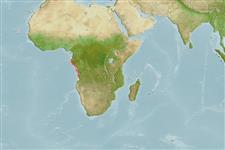Common names from other countries
>
Scombriformes (Mackerels) >
Trichiuridae (Cutlassfishes) > Lepidopodinae
Etymology: Lepidopus: Greek, lepis = scale + Greek, pous = foot (Ref. 45335).
Environment: milieu / climate zone / depth range / distribution range
Ecología
marino bentopelágico; rango de profundidad 20 - 500 m (Ref. 10818). Tropical; 2°N - 18°S, 4°E - 14°E (Ref. 6181)
Eastern Atlantic: equator to 14°30'S.
Tamaño / Peso / Age
Maturity: Lm ? range ? - ? cm
Max length : 43.0 cm SL macho / no sexado; (Ref. 6181)
Radios blandos dorsales (total) : 83 - 89; Espinas anales: 2; Radios blandos anales: 48 - 53; Vértebra: 91 - 96. Upper head profile slightly convex, rising gently from snout to nape; posterior confluence of frontal ridges before rear margin of orbits. Orbits nearly touching upper profile, interorbital space strongly convex. Pelvic fins reduced to 1 scale-like spine and 1 - 2 tiny soft rays. Pyloric caeca 13. Color is silvery; edges of jaws and opercle blackish.
Juveniles epipelagic to mesopelagic from 20 to 220 m (Ref. 6181).
Life cycle and mating behavior
Maturities | Reproducción | Spawnings | Egg(s) | Fecundities | Larva
Nakamura, I. and N.V. Parin, 1993. FAO Species Catalogue. Vol. 15. Snake mackerels and cutlassfishes of the world (families Gempylidae and Trichiuridae). An annotated and illustrated catalogue of the snake mackerels, snoeks, escolars, gemfishes, sackfishes, domine, oilfish, cutlassfishes,. scabbardfishes, hairtails, and frostfishes known to date. FAO Fish. Synop. 125(15):136 p. (Ref. 6181)
IUCN Red List Status (Ref. 130435)
CITES (Ref. 128078)
Not Evaluated
Threat to humans
Harmless
Human uses
Herramientas
Special reports
Download XML
Fuentes de Internet
Estimates based on models
Preferred temperature (Ref.
115969): 13.2 - 17.3, mean 15.4 (based on 19 cells).
Phylogenetic diversity index (Ref.
82804): PD
50 = 0.5156 [Uniqueness, from 0.5 = low to 2.0 = high].
Bayesian length-weight: a=0.00275 (0.00105 - 0.00724), b=3.06 (2.83 - 3.29), in cm Total Length, based on LWR estimates for this (Sub)family-body shape (Ref.
93245).
Nivel trófico (Ref.
69278): 3.7 ±0.4 se; based on size and trophs of closest relatives
Resiliencia (Ref.
120179): Alto, población duplicada en un tiempo mínimo inferior a 15 meses (Preliminary K or Fecundity.).
Fishing Vulnerability (Ref.
59153): Moderate vulnerability (41 of 100).
